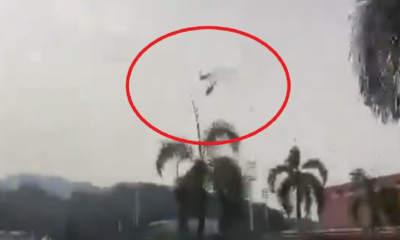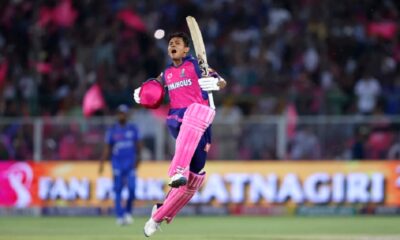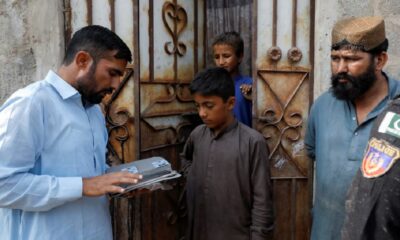Science & Technology
North Korea’s first spy satellite is ‘alive’, can manoeuvre, expert says

North Korea’s first spy satellite is “alive”, space experts said on Tuesday, after detecting changes in its orbit that suggested Pyongyang was successfully controlling the spacecraft – although its capabilities remain unknown, Reuters reported.
After two fiery failures, North Korea successfully launched the Malligyong-1 satellite into orbit in November. Pyongyang’s state media claimed it has photographed sensitive military and political sites in South Korea, the United States and elsewhere, but has not released any imagery. Independent radio trackers have not detected signals from the satellite.
“But now we can definitely say the satellite is alive,” Marco Langbroek, a satellite expert at Delft University of Technology in the Netherlands, wrote in a blog post.
From Feb. 19-24, the satellite conducted manoeuvres to raise its perigee, or the lowest point in its orbit, to 497 km from 488 km (308.8 miles from 303.2 miles), Langbroek said, citing data from the U.S.–led Combined Space Operations Center.
“The manoeuvre proves that Malligyong-1 is not dead, and that North-Korea has control over the satellite – something that was disputed,” he said.
South Korea’s Defence Ministry said it too had assessed that the satellite was in orbit, but said it would not comment further on individual analyses. On Monday, Defence Minister Shin Won-sik said the satellite was not showing any signs of performing other tasks or engaging in reconnaissance.
“While we indeed currently cannot be sure whether the satellite does successfully take imagery, it at least performs orbital manoeuvres, so in that sense it is functional,” Langbroek wrote of Shin’s comments.
The orbit-raising manoeuvre was a surprise as the presence of an onboard propulsion system was unexpected and previous North Korean satellites never manoeuvred, he said.
“Having the capacity to raise the satellite’s orbit is a big deal,” Langbroek said.
That meant that as long as there was fuel in the satellite, North Korea could prolong the satellite’s lifetime by raising its altitude when it got too low because of orbital decay, he concluded.
Harvard astronomer and orbital tracker Jonathan McDowell said the satellite appeared to be correcting its position in space as it moved to where it was shortly after launch, instead of making a hostile move toward another country’s satellite – a capability for which he said the satellite was “much too small.”
The United States, Russia and China, the world’s top space powers, have in recent years launched satellites increasingly capable of manoeuvring and inspecting other orbital objects as space grows as a critical arena for communications, commerce and military activity.
But companies and countries often manoeuvre their satellites to improve the object’s position in orbit. A variety of other reasons to manoeuvre include dodging other satellites or a piece of space debris or – depending on the satellites’ capability – wading above a region of interest on Earth.
U.S. Space Command, which tracks all active objects in orbit and sometimes assesses their function, did not immediately comment on the North Korean satellite, read this report.
Nuclear-armed North Korea has vowed to launch three more spy satellites in 2024.
Science & Technology
Apple loses top phonemaker spot to Samsung as iPhone shipments drop, IDC says

Apple’s (AAPL.O), opens new tab smartphone shipments dropped about 10% in the first quarter of 2024, hurt by intensifying competition by Android smartphone makers aiming for the top spot, data from research firm IDC showed on Sunday.
Global smartphone shipments increased 7.8% to 289.4 million units during January-March, with Samsung (005930.KS), opens new tab, at 20.8% market share, clinching the top phonemaker spot from Apple, Reuters reported.
The iPhone-maker’s steep sales decline comes after its strong performance in the December quarter when it overtook Samsung as the world’s No.1 phone maker. It’s back to the second spot, with 17.3% market share, as Chinese brands such as Huawei gain market share.
Xiaomi, one of China’s top smartphone makers, occupied the third position with a market share of 14.1% during the first quarter, read the report.
South Korea’s Samsung, which launched its latest flagship smartphone lineup – Galaxy S24 series – in the beginning of the year, shipped more than 60 million phones during the period.
Global sales of Galaxy S24 smartphones jumped 8%, compared to last year’s Galaxy S23 series during their first three weeks of availability, data provider Counterpoint previously said.
In the first quarter, Apple shipped 50.1 million iPhones, down from 55.4 million units it shipped same period last year, according to IDC.
Apple’s smartphone shipments in China shrank 2.1% in the final quarter of 2023 from a year earlier.
The drop underscores the challenges facing the U.S. firm in its third biggest market, as some Chinese companies and government agencies limit employees’ use of Apple devices, a measure that mirrors U.S. government restrictions on Chinese apps on security grounds.
The Cupertino, California-based company in June will hold its Worldwide Developers Conference (WWDC), where it will highlight updates to the software powering iPhones, iPads, and other Apple devices.
Investors are closely watching for updates on artificial intelligence development at Apple, which has so far spoken little about incorporating the AI technology into its devices. The company earlier this year lost the crown as the world’s most valuable company to Microsoft (MSFT.O), opens new tab, Reuters reported.
Science & Technology
China launch of relay satellite Queqiao-2 for lunar probe mission successful

China National Space Administration (CNSA) said on Friday its launch of a key signal relay satellite was a “complete success” and it would serve as the communication bridge for its future lunar probe missions for years to come, state media reported.
China launched the satellite Queqiao-2, which was named after a mythological bridge made of magpies, and two miniature satellites, Tiandu-1 and Tiandu-2, on March 20.
Queqiao-2 will be used as a communications bridge between the ground operations on earth and upcoming lunar probe missions on the far side of the moon until at least 2030.
The moon’s near side always faces earth. That means data transfers from the far side are impossible because there is no direct line of sight.
Queqiao-2 researcher and developer Xiong Liang described the satellite as “the main switch” of the whole fourth phase of lunar missions, according to state television CCTV.
“Only when the main switch is flipped on, all the communications can kick off,” Xiong said.
Queqiao-2 will orbit the moon and relay signals to and from the Chang’e-6 mission, which expected to be launched in May. The robotic Chang’e-6 probe will seek to retrieve samples from an ancient basin, acquiring lunar material from the moon’s hidden side for the first time.
Queqiao-2 will also be used as a relay platform for the Chang’e-7 lunar mission in 2026 and the Chang’e-8 mission in 2028.
The functions and performance of Queqiao-2 met mission requirements and it will be able to provide relay communication services for China’s lunar exploration projects and future lunar missions for China and other countries, said the CNSA, according to CCTV.
Queqiao-2 entered its targeted elliptical orbit on April 2 after a correction midway, near-moon braking and orbital manoeuvre around the moon, CNSA said.
The satellite has successfully communicated with Chang’e 4, which was the first spacecraft to perform a soft landing on the far side of the moon and is still carrying out its exploration mission. It also communicated with the Chang’e-6 probe while it is still on the ground earlier this month.
The successful launch of Queqiao-2 comes after the failed launch of another lunar spacecraft DRO-A/B satellites, which was intended to enter the moon’s distant retrograde orbit (DRO).
China has not released any information on whether or not the satellites can be retrieved.
(Reuters)
Science & Technology
Russia aborts planned test launch of new heavy-lift space rocket

Russian space officials on Tuesday aborted the test launch of a new heavy-lift rocket from its far-eastern launch pad.
The Angara-A5 rocket was scheduled to lift off from the Vostochny space launch facility at 0900 GMT Tuesday, but the launch was aborted two minutes before, AP reported.
Yuri Borisov, head of Roscosmos state space corporation, said the automatic safety system canceled the launch after registering a flaw in the oxidizer tank pressurization system.
He said the next launch attempt was set for Wednesday.
Tuesday’s launch was to be the fourth for the Angara-A5, a heavy-lift version of the new Angara family of rockets that has been developed to replace the Soviet-designed Proton rockets.
-

 Latest News4 days ago
Latest News4 days agoRashid Khan named AWCC’s brand ambassador
-

 World4 days ago
World4 days agoMalaysian navy helicopters collide in mid-air, 10 killed
-

 Sport4 days ago
Sport4 days agoJaiswal ton powers Rajasthan to big IPL win
-

 World4 days ago
World4 days agoNorth Korea officials visit Iran in a rare public trip
-

 Latest News5 days ago
Latest News5 days agoAt least 1,500 families affected by recent floods: IRW
-

 Sport5 days ago
Sport5 days agoMawj Sahil player scores stunning halfway line goal in 1-0 win over Jawanan Wahedi
-

 Sport3 days ago
Sport3 days ago‘Serious talent’ Fraser-McGurk bonds with Warner to light up IPL
-

 Latest News4 days ago
Latest News4 days agoUS report cites ‘significant deterioration’ in Afghan women’s rights last year
























